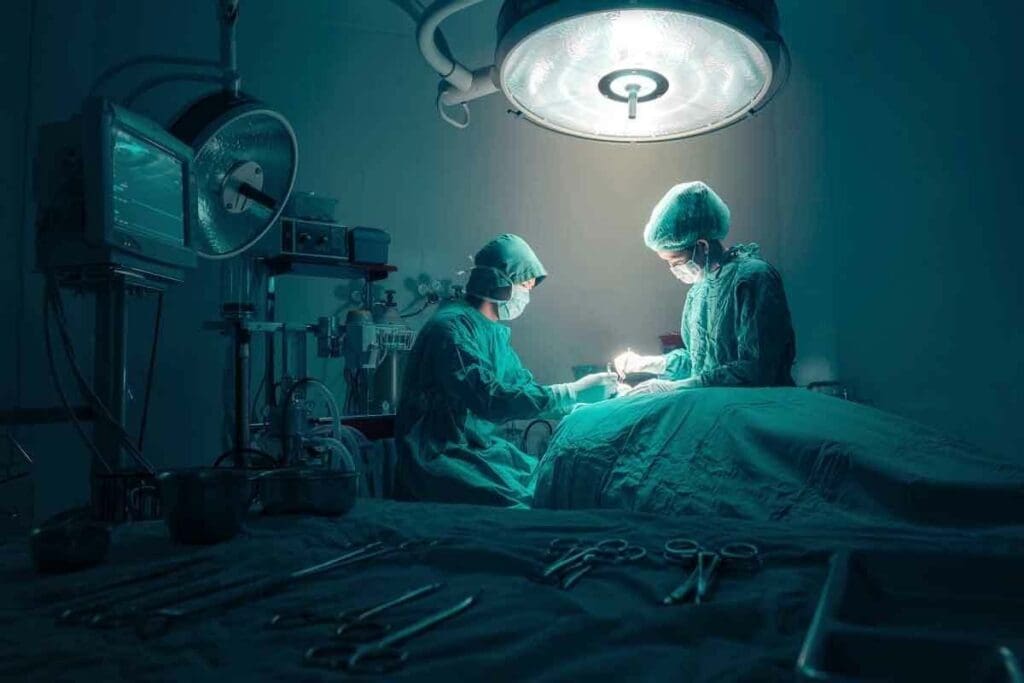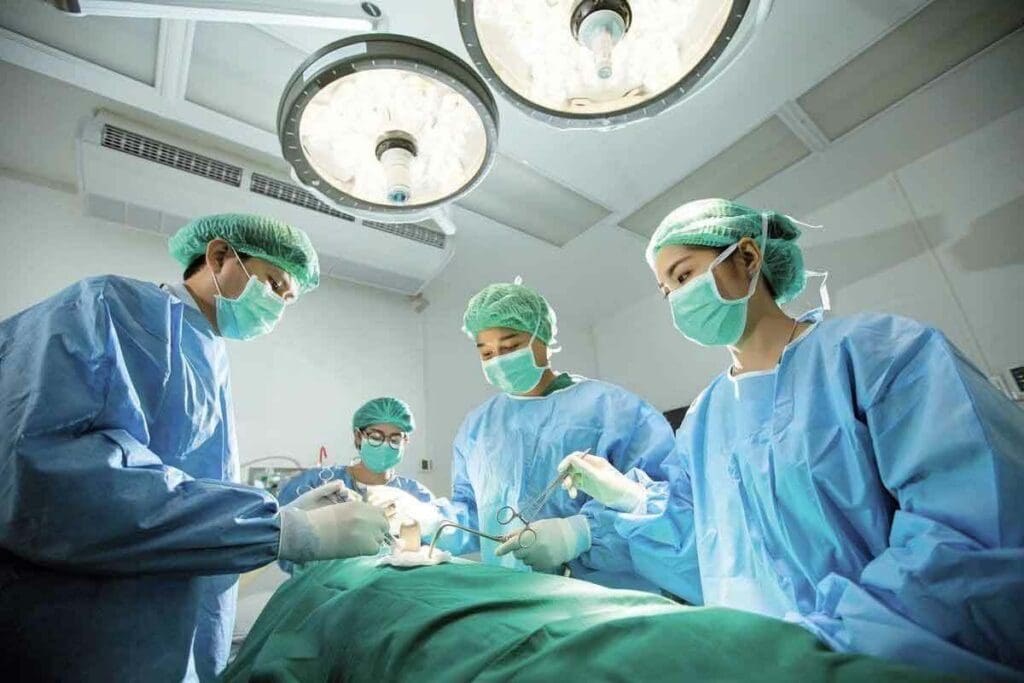Last Updated on November 17, 2025 by Ugurkan Demir

Thinking about bone marrow donation? It’s key to know the risks and side effects. At Liv Hospital, we focus on your safety and giving you all the facts. This way, you can make a choice that’s right for you.
Donating bone marrow is usually safe, but serious problems can happen. You might see a small scar on your hip where the marrow is taken. But this scar usually goes away over time. We’ll talk about the possible problems that can come from donating bone marrow.

Learning about bone marrow donation can ease worries and encourage more people to donate. It’s a detailed process from the first screening to the donation itself. We’ll explain how it works, the collection methods, and who can donate.
Bone marrow donation collects stem cells to help those with serious diseases. It starts with a screening to match the donor and recipient. This includes blood tests and health checks.
The actual donation process can be done in two ways: PBSC donation or bone marrow harvest. PBSC donation uses apheresis to collect stem cells from the blood. Bone marrow harvest takes stem cells directly from the bone, usually from the hip.
There are two main ways to collect bone marrow: PBSC donation and bone marrow harvest. PBSC donation is less invasive. It uses a medication to move stem cells into the blood, then collects them through a vein. This method is simpler and safer.
Bone marrow harvest is a surgical procedure. It involves anesthesia and extracting marrow from the hipbone. Though more invasive, it’s safe when done by experts.
To donate bone marrow, you must meet certain criteria. You need to be healthy, between 18 and 44 years old, and have no certain medical conditions. A screening checks your health and compatibility with a recipient.
Eligibility criteria can change slightly by registry or center. But the main goal is to ensure the donor’s safety and the quality of the marrow.

After bone marrow donation, a small scar forms at the site. It’s usually minor, but knowing about it can ease worries for donors.
The scar is found at the hip, where the marrow is taken. It’s small, like a minor surgery scar. A study found that most scars are minor, causing little pain..
Donors should expect a scar. Its visibility can change based on healing and the extraction method.
At first, the scar might look red or raised. But it usually fades and becomes less visible over time. Healing times vary, but some scars almost disappear in a year or two.
Good wound care after donation can make the scar less noticeable. Keeping the area clean and following care instructions helps.
“Proper wound care is key to reducing scar visibility after bone marrow donation.”
– Medical Expert
While scars are part of donation, there are ways to make them less noticeable. Here are some tips:
Below is a table with tips for reducing scar visibility:
| Tip | Description | Benefit |
| Proper Wound Care | Keep the area clean and follow post-donation instructions | Reduces risk of infection and promotes healing |
| Sun Protection | Avoid direct sun exposure on the scar | Prevents darkening of the scar |
| Topical Treatments | Use treatments as advised by healthcare providers | Can help reduce scar visibility |
Understanding and taking steps to minimize the scar can help donors. It’s a small price for helping someone in need.
Hip and back pain are common after bone marrow donation. These symptoms happen because of the donation process, mainly if marrow is taken from the hip.
The pain after bone marrow donation comes from the surgery to take out the marrow. Taking marrow from the hip can cause pain in the hip and back. This pain is usually because of the body’s healing and can be managed with care.
The pain’s length and how bad it is can differ for everyone. Usually, the pain is worst in the first few days after donation. It gets better as the body heals. Most people see the pain lessen in a few weeks, but some might feel a bit of pain longer.
Managing hip and back pain after donation needs both medical help and self-care. Donors often get pain medicine to ease the discomfort. Rest, gentle exercises, and using heat or cold packs can also help. It’s key to follow the advice from your healthcare team for proper healing and less pain.
Understanding why hip and back pain happen after donation and using good pain management can help donors recover. While everyone’s experience is different, most find the pain manageable. With the right care, they can get back to their usual activities in a short time.
The bone marrow donation process is vital for recipients, but can leave donors feeling very tired. This tiredness is a natural response to the donation. We’ll look into why donors get tired, how long it takes to get better, and offer ways to regain energy.
Donors feel tired because their body has fewer red blood cells and hemoglobin after donation. The bone marrow donation process is hard on the body. It lowers energy levels temporarily.
Most donors start feeling better a few weeks after donation. The time it takes to get back to normal varies. But, generally, it’s 2 to 4 weeks. It’s key to follow the care instructions from your medical team for a smooth recovery.
To boost energy, donors should:
By following these tips and giving your body time to heal, most donors can get back to their usual activities in a few weeks. Many feel ready to do normal things in just a few days. But it’s important to listen to your body and not rush the healing process.
Bone marrow donation is a lifesaving act, but it can lead to headaches and changes in thinking for some. Donors need to know about these side effects to prepare for recovery.
Headaches after bone marrow donation can happen for a few reasons. These include dehydration, the effects of anesthesia, and how the body reacts to the donation. Dehydration is a big issue if donors don’t drink enough before and after the procedure.
To manage headaches, rest, drink lots of water, and take over-the-counter pain meds as your doctor suggests. Staying hydrated is key, and doctors often tell donors to drink plenty of water.
Most headaches after donation are not serious and can be managed. But if your headaches are very bad, getting worse, or if you have other symptoms, you should see a doctor.
| Cause | Management | When to Seek Help |
| Dehydration | Hydration, rest | Severe headache |
| Anesthesia effects | Over-the-counter pain relief | Headache persists or worsens |
| Reaction to donation | Medical guidance | Accompanied by other symptoms |
Bone marrow donation can cause bruising and bleeding. Knowing what to expect can ease worries. These effects are usually short-lived and can be managed.
Bruising often happens where the marrow was taken out. For peripheral blood stem cell donation, it may show up where the IV line was put in. Sometimes, donors might see bruising in the hip or back if bone marrow was harvested.
Some bleeding is okay right after the procedure, like at the needle sites. But it’s key to tell normal from abnormal bleeding. Normal bleeding is light and stops soon. Abnormal bleeding is heavy, lasts long, or keeps coming back and needs a doctor’s help.
Donors should watch their bleeding and get help if it’s not right.
How fast bruises heal varies. They change colors as they heal, from red or purple to green, yellow, and then fade. Most bruises heal in a few weeks.
Knowing about bruising and bleeding after bone marrow donation helps with recovery. These side effects are usually short-term. Knowing what’s normal and what’s not is key to a safe recovery.
Bone marrow donation is usually safe, but there are rare serious complications. It’s important to know about these risks to make informed choices.
Nerve injury is a rare but possible side effect of bone marrow donation. It can happen from the needle insertion or the harvesting process. Symptoms include numbness, tingling, or pain in the affected area.
Key risks and symptoms to watch for:
Infection is a rare but possible complication after bone marrow donation. The risk is low with proper wound care and medical follow-up.
Signs of infection include:
| Risk Factor | Prevention Measure | Signs of Complication |
| Poor wound care | Proper cleaning and dressing | Redness, swelling, increased pain |
| Inadequate follow-up | Regular medical check-ups | Fever, chills, discharge |
Some bone marrow donation procedures use anesthesia. While rare, anesthesia-related problems can range from mild to severe.
Donors should talk to their healthcare provider about anesthesia options and risks.
Knowing how long it takes to recover after bone marrow donation is key. It helps donors plan their return to normal life. Recovery times can differ, but there are general guidelines to follow.
The first 48 hours are very important for recovery. Donors might feel fatigue, dizziness, and pain at the donation site. Resting is essential during this time.
Donors should avoid hard work, like heavy lifting and bending. It’s best to rest and let others help with daily tasks.
By the end of the first week, many donors start to feel better. But,it’ss important to keep taking it easy. Listening to your body and pacing yourself is key.
| Activity | Recommended Status |
| Light Exercise | Gradually resume |
| Strenuous Exercise | Avoid for at least 2 weeks |
| Work | Typically re,sume within 1-2 weeks |
Most donors fully recover in a few weeks. But, he exact time can vary. Health, donation method, and following care instructions play a big role.
In conclusion, while recovery times vary, knowing the basics helps. Following healthcare advice is key to a smooth recovery. It ensures donors can return to normal life safely.
Donation centers use a detailed plan to keep donors safe during bone marrow donation. This plan includes several important steps. These steps work together to protect the health of donors.
Before starting, donors go through a detailed screening. This checks for any health issues that could cause problems. They look at medical history, do physical exams, and run lab tests.
This screening is key to finding out who can safely donate. It helps make sure only healthy donors go ahead with the process. This way, the donation is safer and better for everyone.
During the donation, doctors keep a close eye on donors. They watch their vital signs and act fast if needed. This is to make sure everything goes smoothly.
Doctors are ready for any problems that might come up. They give donors the care they need right away.
After donating, donors get a lot of care. This includes managing pain, checking for problems, and helping with recovery. They also have follow-up visits to check on their health.
Good care after donation is key. It helps donors avoid long-term problems and get back to feeling normal.
Bone marrow donation is generally safe. Serious problems are rare. Most donors only have mild side effects. Severe issues happen in a small number of cases.
| Complication | Frequency |
| Serious Adverse Events | Less than 1% |
| Mild to Moderate Side Effects | Approximately 80% |
| No Complications | Around 20% |
The safety of bone marrow donation shows how well donation centers care for donors. Knowing these numbers helps donors make smart choices about donating.
We’ve looked at the risks and side effects of bone marrow donation. Issues like fatigue and bruising are common. But, sseriouscomplications are rare. Despite these, the benefits of donating bone marrow are huge, saving lthe livesof many patients.
The advantages of bone marrow donation are many. It gives patients with serious diseases a second chance at life. It also helps in medical research and the creation of new treatments. When we weigh the risks against the benefits, it’s clear that the good outcomes are much greater than the temporary discomforts and risks for donors.
It’s important to know about the risks of bone marrow transplant for donors. But we must also see the huge impact it has on recipients. As medical technology and care improve, bone marrow donation becomes safer and more effective. This makes it even more valuable as a lifesaving option.
Bone marrow donation is mostly safe. But there are risks like infection, bleeding, nerve damage, and reactions to anesthesia. We do a lot to lower these risks. This includes checking donors before donation and watching them closely during the process.
Recovery time varies for each person. Most donors can get back to normal in a few days to a week. It’s key to follow the care instructions after donation to recover well.
Yes, some pain or discomfort is normal after donation, mainly in the hip and back. We help manage this pain with strategies and medication. Most donors can handle their pain well.
It depends on your condition and how serious it is. We look at each donor’s health and medical history. Some conditions might stop you from donating, while others might not.
Collecting bone marrow is a surgical procedure. We take marrow from the hip bone using a special technique. This method aims to reduce discomfort and ensure a safe, efficient process.
Yes, you’ll likely have a small scar where the marrow was taken. The scar’s size and where it is can vary. But, it’s usually small and fades over time. We give tips on making the scar less noticeable.
Most donors don’t face long-term health issues from donation. We take many steps to keep donors safe. The risks of donation are carefully managed.
Follow the screening instructions before donation and the care guidelines after. Also, tell our medical team about any concerns or symptoms. This helps lower the risks of donation.
The procedure is done under anesthesia, so donors usually don’t feel pain during it. But some might feel discomfort or pain after. This can be managed with medication.
Some donors might have headaches or feel mentally affected after donation. But,these effects are usually short-term and go away on their own. We help manage these symptoms and know when to seek help.
We follow strict safety steps. This includes screening donors before, supervising them during collection, and caring for them after. These measures ensure donor safety and reduce donation risks.
Subscribe to our e-newsletter to stay informed about the latest innovations in the world of health and exclusive offers!